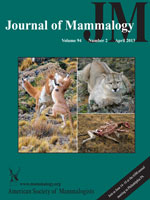Quantifying distributions, home ranges, and individual movements for wildlife species is crucial for understanding their ecology and is important for conservation. This has become especially urgent for bat species affected by white-nose syndrome, a new disease of hibernating bats associated with the fungus Geomyces destructans. We studied within- and between-season movements of individual little brown bats (Myotis lucifugus) throughout a 337,540-km2 study area in Manitoba and northwestern Ontario, Canada. Our objectives were to quantify proportions of male and female bats that relocated from hibernacula and/or summer roosts between years, proportions of males and females captured at swarms that hibernated at those sites versus other hibernacula, and distances traveled by males and females during relocation events. We predicted that bats would exhibit male-biased dispersal, with males significantly more likely to relocate and more likely to travel long distances during relocation events. Between 1989 and 2010, we recaptured 1,459 of 10,432 banded individuals. Seasonal movements from hibernacula and/or swarms to summer colonies ranged widely from 10 to 647 km. Consistent with previous studies we found high fidelity to summer colonies and hibernacula across years. However, some individuals switched sites between years and the median relocation distance was 315 km, with over 20% of individual movements exceeding 500 km. Surprisingly, we found that females were significantly more likely to relocate than males. Our data could help explain apparent jumps in the distribution of G. destructans, but more data on transmission of the fungus in the wild are needed.
How to translate text using browser tools
1 April 2013
Long-distance movements of little brown bats ( Myotis lucifugus)
Kaleigh J. O. Norquay,
Felix Martinez-Nuñez,
Jack E. Dubois,
Kim M. Monson,
Craig K. R. Willis
ACCESS THE FULL ARTICLE

Journal of Mammalogy
Vol. 94 • No. 2
April 2013
Vol. 94 • No. 2
April 2013
Chiroptera
long-distance dispersal
mammals
migration
white-nose syndrome
wildlife disease




